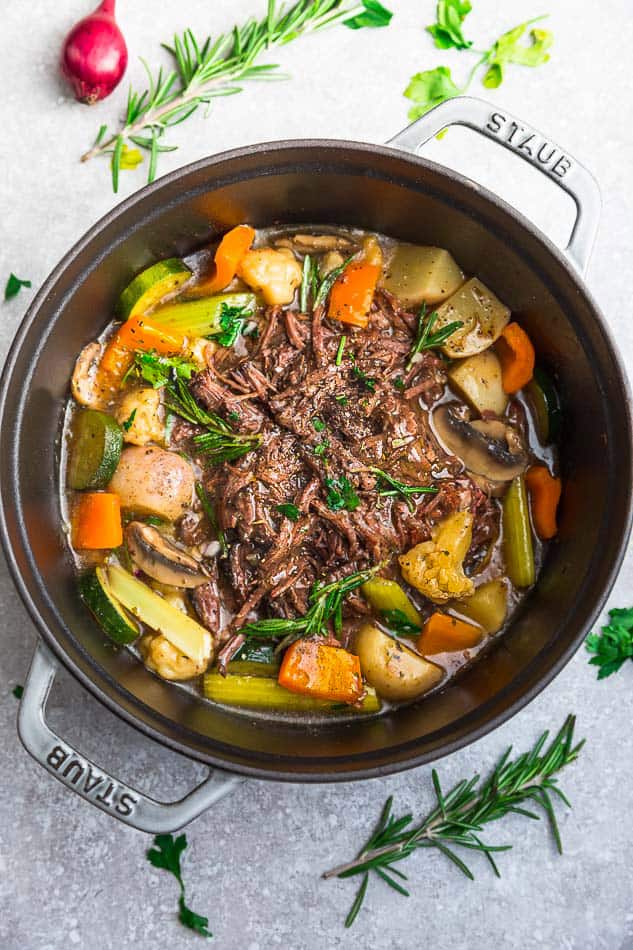

If after cooking the pot roast, it is still tough, all you need to do is cook it longer. You can see what this looks like in the photo and video above. The beef should fall apart on you, which means that the pressure cooker has done its job in breaking down all the connective tissue in the beef. Pot roast is done when it’s tender and easily pulled apart with a fork. You can also just spoon the liquid in the pot over the beef when serving. I have provided a method in the recipe below. If you added potatoes, you can serve them alongside the beef or mash them.Īs an optional step, you can make a gravy with the liquid left in the pot. The celery becomes tender, too, but I usually don’t serve them with the beef since by the end of the cooking time they have usually given up all their flavor to the gravy.
POT ROAST INSTANT POT MANUAL
If you are new to the Instant Pot or electric pressure cooking, I recommend reading the user’s manual before following our recipe.Īfter cooking, the beef will be tender, the onions melt into the gravy, and the carrots turn silky soft. By naturally release, I mean that when the cooking time is up, I leave the pressure cooker alone and allow it to slowly release some of the pressure built up inside the pot.Īfter about 10 minutes, I use the quick-release button to release the remaining pressure before opening the lid. Step 6, Naturally release the pressure cooker for 10 minutes and serve. The beef and carrots are so tender that adding a crisp, roasted potato next to them is a nice change in texture.

These get very soft and can be served whole or mashed into flavorful mashed potatoes.Īlternatively, you can leave them out and roast potatoes in the oven for a more crisp result. You can see from our photos that we added baby potatoes to the pot, too. So, a 3-pound roast takes 60 minutes at high pressure before it is tender. In general, you will need twenty minutes of cooking time at pressure for every pound of meat. As I mentioned above, the cooking time will vary depending on the size of beef you are cooking. Step 5, Pressure cook until the beef is tender. When the bottom of the pot is clean, I place the beef, vegetables, and more aromatics into the pressure cooker. By deglazing, we lift all that flavor stuck to the bottom of the pan. The steps where we brown the beef and vegetables leave bits stuck to the bottom. By deglaze, I mean to add liquid and scrape the bottom of the pot until it is clean. Step 4, Deglaze the pot and place the beef and vegetables back in. When they start to smell sweet and get light brown in places, I take them out and move on to making the braising liquid. This step builds even more flavor into the dish, which makes the braising liquid taste incredible. For extra flavor, we add onions, carrots, and celery to our pot roast, but I like to cook them in the bottom of the pot a bit first. If your pressure cooker does not have this function, simply brown the beef in a heavy pan on the stove.Īfter browning, I remove the beef so I can move on to the veggies. By browning the beef on all sides before cooking at high pressure, we add color to the meat and add lots of flavor to the pot.įor a one-pot meal, brown the beef right in the pressure cooker using the “ Saute” function. In this time, the salt seeps into the meat and helps to season and tenderize it. I also love that the beef gets a chance to sit with the salt for about an hour before cooking. I’ve already touched on this above, but I’ll quickly do it again, here.Īfter testing, we found that when we left the beef out on the counter to come closer to room temperature before cooking it, the pot roast was much more tender at the end of the cooking time. Step 1, Season the beef and bring it to room temperature. If you own one of them, you should be able to use this recipe without any problems (just make sure you read the user manual first). Other brands make electric pressure cookers, too.


 0 kommentar(er)
0 kommentar(er)
